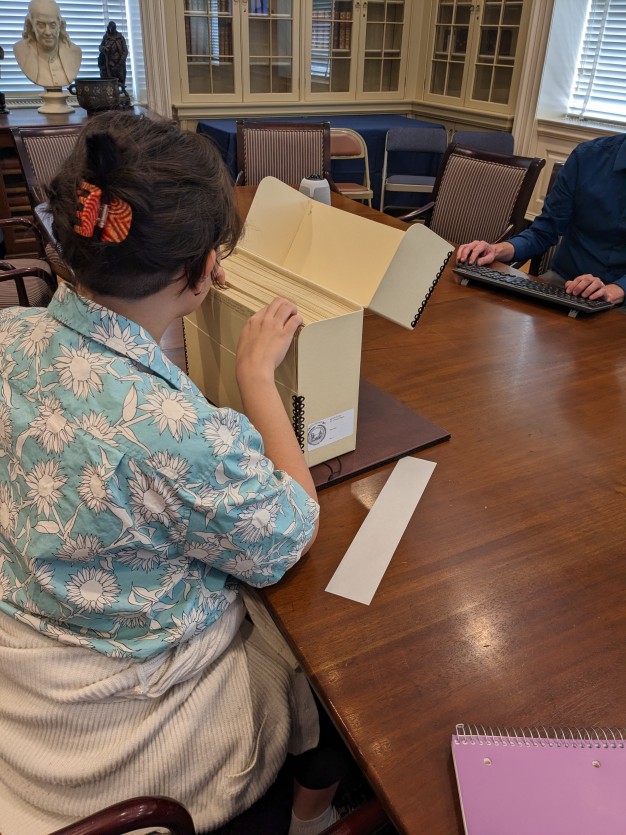Indigenizing the Finding Aid
When I came from my home in Kansas, I was excited to be in Philly for the summer. I was drawn to the Native American Scholars Initiative internship at the Center of Native American and Indigenous Research (CNAIR), because of CNAIR’S openly-declared commitment to making archival materials more accessible to Indigenous communities. My research project from the past summer was an extension of this and a consideration of my positionality at the American Philosophical Society (APS).
My summer project “Indigenizing the Finding Aid,” is an attempt to change what has traditionally been a finding aid. Finding aids are used by archivists to summarize collections, but how does being an Indigenous (Prairie Band Potawatomi and Choctaw) person change that process? My main priority is to respect the communities that these materials are coming from, but how does one do that in the space of a finding aid? At a place like the APS, which has a long and colonial history, this is something that is vital to take into consideration.
Considering the scope of this project, I had to be aware of my position at the APS. We all approach different subjects from our own perspectives. Race, class, sexuality, and gender are just a few examples of what can impact how we do research or how we view various topics. This concept is called “positionality.” What is only beginning to be talked about is that research has primarily been from the perspective of straight, wealthy, white men who have the time and resources to do research. Academia and research have systematically kept out people with minority statuses, such as people of color and women.
However, recently, academia and research have become a little more open to different people. As academia and research become more accepting, there is richer and more diverse research being created. For example, when considering research done by Indigenous people regarding Indigenous people, there is the addition of a somewhat similar worldview. This similar worldview may help a researcher pick out important concepts that other researchers might view as unimportant. All of this consideration lead to my project at the APS.

Over the summer, CNAIR received a donation of Ktunaxa and CHamorro linguistic materials recorded by linguist Paul Garvin primarily in 1950. This accession contains reel-to-reel audio tapes and transcripts for some of these tapes. At the library, I created a finding aid for this accession. As collections can contain a lot of information, a finding aid can help understand what is in it.

By detailing key people, places, and subjects mentioned within a collection, finding aids make said collections more accessible for community members and researchers. The finding aid will also provide Ktunaxa and CHamorro communities with this information, so they can decide if they would like to access materials from this collection. Making the details of a collection easily accessible is especially important for materials addressing Native and Indigenous people. Previously in archives, finding aids of Indigenous materials would not contain specific details, such as interview participant’s names. Sometimes collections were only labeled with the sovereign nations of participants, and even that was not always accurate. At CNAIR, there has been an attempt to remedy this by providing more information and digitizing materials.
Additionally, creating a finding aid has been a difficult task because the systems of creating finding aids do not support Indigenous ways of knowing. This relates back to positionality. There are materials from these collections I felt uncomfortable reading, or that I stopped reading because I know there are things not meant for me. I am aware of similar concepts from my own culture and the weight they hold. Not everything is for me, and that’s something I am absolutely okay with. I acknowledge that this isn’t a perfect process. I’m not from the Ktunaxa or CHamorro communities, and am doing this work far away from where they are. On top of that, I’m doing this in a colonial institution. In my dreams, communities can have access to and decide what they want to do with their own materials.
“Indigenizing the Finding Aid” has been a space for me to continue the growing legacy of dreaming up Indigenous futurisms, specifically in the archival space. While presenting my project at the APS and talking about possible futures of the archives, an audience member brought up possible limitations for this project. If you are an Indigenous person who has interacted with the archival space, I’m sure you have heard these next few comments. People will say, “Communities don’t have the space for this stuff!” or, “Everyone is so overworked!”. These are valid reasons when coming from Indigenous people themselves, but why must we dream within the limits of the colonial institution? I am simply one person and I know I cannot change the whole system. This is not my goal (at least for this summer). If one person walks away with visions for different futures outside of “This is the way we’ve always done things,” I will have reached my objective. Hopefully, through all of these considerations, I created a little Indigenous universe of respect in the finding aid.
When published, the finding aid will be accessible online and under the call number Mss.Ms.Coll.281.

